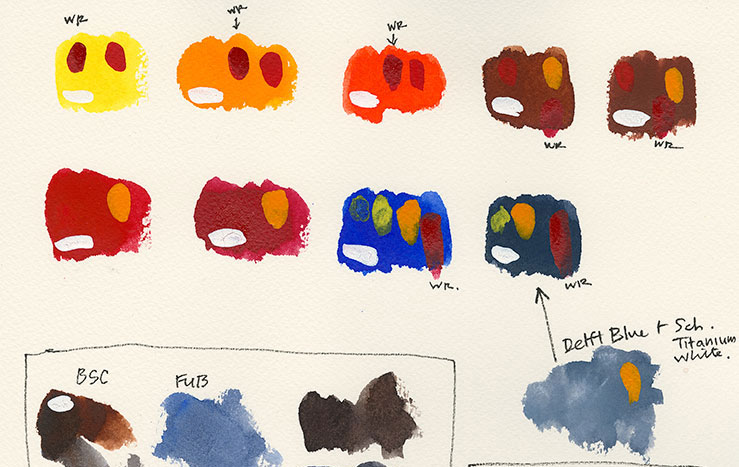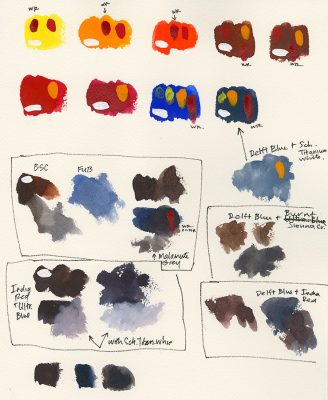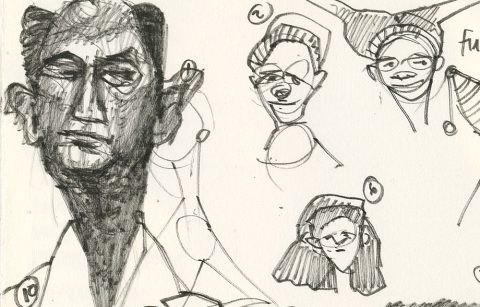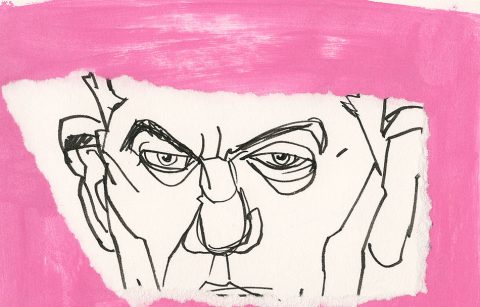Everyone who reads my blog knows that I love gouache. I have since childhood. So I was excited to see a new gouache, Stoneground Gouache, bring out a line of gouache in pans. Who doesn’t like the ease of having pans of paint when out and about?
I’ve done a video product review you can see here.
Read the rest of this post for additional information and context, and decisions I made about the paint under review.
What I Currently Use
I like taking gouache with me by using my tubed Schmincke Gouache and making my own field pans. I fill 1/3, 1/3, 1/3, letting it completely dry at each filling.
I’ve been doing this for 23 years (since I first had access to Schmincke Gouache).
I don’t have any problems with this method. And I have no trouble getting thick, saturated paint to use from the pans, because Schmincke Gouache rewets exceptionally well. (Holbein Gouache doesn’t rewet well and cracks when it dries in the pan so while I have a few colors of it I use for flat color backgrounds I don’t make pans out of it.)
Currently if I want fresh gouache out in the field I simply put fresh Schmincke Gouache in pans in a palette with a tight fitting lid. I do this in the morning before I head out. The goal is to put in sufficient quantity for the day (which I have a sense of since I’ve been doing this so long and I know what I’m going out to paint. I do not want them dry in this approach.) Next I put a small square of folded paper towel, about 1 inch square, moistened with water, in the top of the box before I close it. That and a quick spritzing of the pans with a small spray bottle of water before I start to sketch, keeps the paint soft enough for me to work with it fresh in the field. And this works even in the heat of the Minnesota Summer (which is humid) or the cold of Minnesota Winter (which is typically very dry). Fresh gouache is something I want to use when I want to quickly get thick colors. While I don’t have trouble getting thick colors from the dried Schmincke gouache pans I make, sometimes you just want to play with fresh paint, and there is a time difference, and the blend ability is easier as you don’t have to worry about bringing up multiple colors to a certain level of saturation to mix. They are simply ready to go.
Both methods work for me: my homemade pans of Schmincke Gouache, and using fresh Schmincke Gouache. It’s usually a matter of where I am going to go and sketch and how much of a potential mess I’m going to make. For instance, I didn’t use fresh gouache at the Bell Museum until the last 5 months that it was open at its original site, because I was concerned about potential mess—like a child stepping in a palette of fresh gouache and leaving a trail!
As you’ll read below I have additional options for working opaquely as well!
But like most people I do long for things to be a little simpler. So when I saw this paint advertised on Wet Paint’s Instagram account, I made an order from them.
Here is the video link to my product review of Stoneground Gouache. I’m sorry I couldn’t get the video to embed in the post today, but you can click on the link and go directly to the video product review. In this video you’ll see the initial tests I do with any gouache paint, and my initial assessment of this Stoneground Gouache pan paint.
Alternatives
Something I thought about as I was writing this review—in the 1980s I had a little box of pan gouache from Winsor and Newton. It was made for illustrators. It was not a set of kid’s gouache. I loved that set. Yes after a bit of use the pans started to crack, but getting thick luscious paint off those pans that were about 1 inch in diameter, was a dream. I don’t know if these pans are still made. It was called “Designer’s Gouache Set,” or something like that. The colors were a standard limited 12 color palette.
Additionally you can find palettes of pan gouache made for kids from Pelikan. I do not recommend these at all. Yes you can pick up some opaque washes from the pans relatively easily, but the paint is very low quality and doesn’t use quality pigments or ingredients. When you try to mix the colors you’ll get a lot of pigment cross contamination that will leave you with muddy looking colors. Can they be used? Yes, but the fun factor, if you want to create vibrant art, is going to be low. Save your money. Yes you can get the entire set of Pelikan for what one pan of Stoneground Gouache or one tube of Schmincke Gouache costs, but your time, effort, and learning is worth honoring. Don’t waste your time. I’ve seen so many students come to my classes frustrated after using Pelikan and believing they can’t paint!
I see that Cara d’Ache makes tube gouache and also sells a small pan gouache set. I have not tried either from them. I assumed from the low cost of the pan set it could not contain the same quality pigments of the other paints I use, so it held little interest to me.
When purchasing inexpensive gouache (tubes or pans) be aware that some manufacturers use binders that have a chemical odor. Try to find the brand in a store to check out the odor first. Winsor and Newton’s line of tube gouache has such a strong odor I can’t even be in the room with it. (And that’s actually not a poor quality paint, it just doesn’t have other characteristics I look for besides odor.)
Holbein Gouache I’ve already mentioned has the tendency to dry out and crack. Additionally they have a lot of 2- and multi-pigment colors which makes mixing vibrant color perilous because of the aforementioned cross contamination of “hidden complements.” And they tend to put white in a lot of their colors (something Stoneground also seems to do if you look at their website and read the pigments used for each pan). I find that this dulls your mixes. I prefer to use colors that are white paint free, and then add white as needed at the end of a painting when I put on the light tints and then the highlights.
But I do have to admit there is a lot of fun factor with the feel of the Holbein Gouache. And it may be something that calls to you and your aesthetic. If so, consider purchasing a Sta-Wet palette and using your Holbein Gouache on that.
DaVinci Gouache is also still available. I don’t recommend it. I used it for one of my International Fake Journal Month Journals and wrote about the “horrors” in the linked blog post on that dedicated blog.
Daniel Smith Gouache is something I begged for over the years, since I was such a devoted Daniel Smith Watercolor user. I have recently purchased a few tubes but haven’t had time, with the downsizing to test it. (Frankly I don’t know which box it is packed in!) I did a quick evening sketch with it when I first got it and wasn’t happy with the movement of the paint and the colors available, but I could also simply have been grumpy that day!!! I’ll eventually dig them out and tell you what I think, but frankly since I have so many ways to get the look I love and enjoy making, I’m not sure I’m going to be a big fan of them. They have a steep hill to climb. Then again, I might use them tomorrow—really use them, and find that they can compete with Schmincke Gouache. I’ll keep you posted.
If you want to read about white gouache you can read my blog post here discussing “which white.” It’s one I left open from the archives because it’s been so popular with people getting into gouache.
Myths about Gouache
If you aren’t using gouache because you’ve been online in one of those chat groups where they are talking about gouache cracking and falling off your page think again.
I’ve been using Schmincke gouache and Holbein gouache in my journals for over 50 years combined (I’ve been using Schmincke since 2000 and Holbein Gouache since my teen years).
I’m a frustrated oil painter and I love to slather on paint—even if it’s watercolor paint I’ll make up a large mix of whatever color I want and use it very opaquely.
Before covid people looked through my past journals quite a lot, and not gently!
Nothing has chipped off or cracked.
And the pages have been bent and turned thousands of times.
So as long as you’re not applying paint with a trowel, go ahead and paint with gouache in your journal. I have used it successfully on non-wet-media papers lighter than 80 lbs! Typically I use it on 90 and 120 lb. watercolor paper.
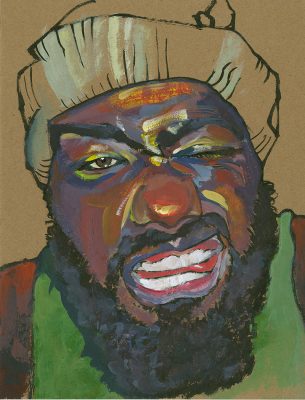
Of course I also use gouache on chipboard and all manner of thicker papers and boards. (My rocks series is on 300 lb. hot press watercolor paper.)
You can see an opaque paint sketch I did on chipboard at the left. The ink lines are still showing through in the hat section as I didn’t paint the hat. (I can’t tell you if this is gouache or watercolor used opaquely as all my journals are still in storage with my notes, but it is water-soluble paint that is used opaquely and it’s on chip board, and I’m slathering it on. I don’t have to worry about it bending and cracking because it is on a stiff substrate—but frankly this is exactly the way I paint in my journal on the lighter weight papers too, without problem.
If you are interested in the look of opaque paint (gouache or watercolor used opaquely) then I encourage you to have at it and really give the paint you select a run for it. Use it as thickly as you can to move it around, use it at the consistency of heavy cream (which is gouache in the traditional approach), and use it on a variety of papers that are of interest to you. And of course use it with whichever drawing tool calls to you.
And once you’ve done that, THEN you can think about whether or not you used it too thickly for the paper you chose, and whether or not you need to restrict who pages through that book.
Here’s the thing. If you start with a quality paint like Schmincke Gouache, or Daniel Smith Watercolor paint then you will be able to do things with the paint you can’t do with inferior paints. And you’ll push the limits of those paints to your own aesthetic and learn and decide when and where you’ve reached a limit to stop at.
Don’t let someone on a discussion board who has used gouache for a total of two times, both ineffectually, tell you what you can and can’t do with the paint.
Who are you going to listen to? Someone who spouts old myths about the paint without regard to the manner in which manufacturing of those paints has changed over the time since the first person who warned them about something dire used an early generation of those paints…or someone who has shelves full of journals and walls full of paintings and has been happily playing with gouache for over 50 years?
They’re telling you to stop.
I’m telling you to have some fun. You’ll find the point beyond which you can’t go. Look if there were something dangerous lurking out there there I would be the first person to warn you, and prepare you. But I think there are a lot of things you have yet to do with paint and I know you want to give it a try.
There are a lot of options in the market right now. Pick one and work with it for 4 weeks and get to know it. Then pick another for the next four weeks. You don’t need to buy a whole line of colors. Stick with a warm and cool of each primary, and because it’s gouache that you’re looking at get a tube of titanium white (to start, later you can try white gouache). Next pick a couple must have colors, like I pick Burnt Sienna—but you know which color you need to have.
After 2 months of this approach you’ll know which of the two paints you prefer, and if you start with Schmincke you’ll probably know all that you need to know to look for in any new paint that comes down the road. You might also find, like I have, that sometimes you feel like using one paint and other time you feel like using a different paint. That’s OK.
But you won’t know that until you start…wait for it…you know I’m going to say it…PRACTICE.
And the practices needs to be adventuresome and fun. And if the danger of crumbling paint makes it a little intense and scary, don’t worry, GO AHEAD and paint anyway. You will be able to deal with it if it happens. You will find what you like.
Don’t be infected by someone else’s timidity! Don’t listen to someone else’s “rules” when they are arbitrary, or don’t make sense, or don’t agree with the observation of your own eyes when you see what other people are doing contrary to those rules.
Be intentional. Sit down with goals and a plan and really attack it and you’ll get it.
When I was 12 years old I was prohibited from buying watercolor paint at the school’s art shop because my account was just blowing up. The amount of paint I was going through shocked my mom into demanding I be taught a less expensive mode of expression—enter the dip pen, and hey, I’m glad for that because you all know how much I love the dip pen. (Thank you Mrs. Osbourne!)
But did that stop me from using the amount of paint I wanted to use? Nope.
What stopped me from using the amount of paint I wanted to use was my asthma—I couldn’t use oil paint.
But I saved my allowance and later saved my wages, and I did my research (which also involved interviewing advertising artists that worked at the company my dad managed) and I bought paint I knew would get results. And I kept using it as thickly as I wanted.
Yes, in the distant past (1980s and 90s) I’ve let students know they need to be a little circumspect about paint usage, too much on a journal page could very well flake off depending on the paint brand and the bending and turning that page is subjected too—but decades of painting this way have given me the background to know that ultimately it has been OK. My journal pages have a been turned repeatedly by hundreds of people.
You can breathe. Just start PAINTING OPAQUELY. (And remember to scan anything as soon as it dries, just ’cause.)
Going Forward
After doing the preliminary test last week and editing the video (to remove coughing and speed up some paint drying times) I realized I would not be using Stoneground Gouache Pans going forward.
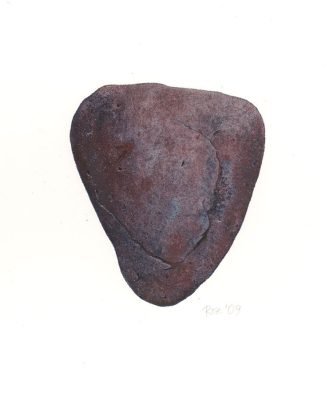
I already have the Schmincke Gouache which I use fresh in the studio, and in homemade pans in the field. Both work brilliantly for me and give me the rich, thick paint that I need to cover those bold Pentel Brush pen lines I love to use when sketching.
Additionally I love using watercolor opaquely, simply by managing my water amount. I find that with Schminke Horadam Watercolor Pans or with Daniel Smith Tube watercolors I have absolutely no problem getting rich thick paint to cover those same bold pen lines. There are literally thousands of examples I’ve shared with you over the years on this blog—and because much of the blog is now in archive I’ve placed some of these images of me using Schmincke Gouache and Schmincke Watercolor and Daniel Smith Watercolor all opaquely at the end of the review video.
I did that so that you’ll understand how I use gouache. Gouache is meant to be used richly and opaquely. Yes you can have translucent passages, but the real strength of gouache lies in the exploration of the opacity of the medium. I encourage you to keep this in mind. Embrace gouache for what it is. That’s my wish for all of you in your painting.
And because I found the Stoneground Gouache pans cannot compete at the same level of my existing opaque options (Schmincke Gouache fresh or in homemade pans, Schmincke Horadam Watercolor Pans or Daniel Smith Tube Watercolors used opaquely by managing water) I am not going to do further explorations with the Stoneground Gouache pans.
Part of testing materials is to know what you already can do and how you do it, so that you can decide if the new material or tool will help you do it better.
The other part of testing is to discover the fun factor of the new tool or media. Can it help you do something new and wonderful that you want to investigate?
For me, after I finished my testing I realized not only did I have several excellent options already, but they all have a great fun factor and they still have possibilities for me to expand my artistic vision.
Just because I’m not pursuing use of this paint line doesn’t mean it might not appeal to you. My comments about what it does in the video will help you assess that. That’s what I like to do in my reviews.
Because I am not going forward with this paint, if you are a local art friend (Minneapolis/St. Paul) and you would like to expand your selection of this line, I’m happy to sell my nine colors (see the video) for the discounted price of $75 (original price of the paints: $131.31).
We can arrange a time when I can drop them off. (This does not include the box shown in the video. The paints didn’t come in a box. I’ll be retaining my box for future palette arrangements—you can purchase boxes like that online for $10 and up.)
Downsizing has made me rather ruthless. There simply is no space to have even nine pans of paint hostage and not being used—better for them to be out of here!
Before you email me about the paints however, think about what you already have on hand? Do you have something you can already use, and something which will work better? It’s my hope that my product reviews get you to think about exactly that. And of course the fun factor!



















